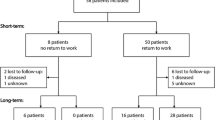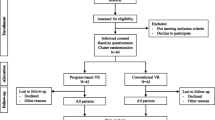Abstract
Purpose Young patients represent a particularly vulnerable group regarding vocational prognosis after an acquired brain injury (ABI). We aimed to investigate how sequelae and rehabilitation needs are associated with vocational prognosis up to 3 years after an ABI in 15–30-year-old patients. Methods An incidence cohort of 285 patients with ABI completed a questionnaire on sequelae and rehabilitation interventions and needs 3 months after the index hospital contact. They were followed-up for up to 3 years with respect to the primary outcome “stable return to education/work (sRTW)”, which was defined using a national register of public transfer payments. Data were analyzed using cumulative incidence curves and cause-specific hazard ratios. Results Young individuals reported a high frequency of mainly pain-related (52%) and cognitive sequelae (46%) at 3 months. Motor problems were less frequent (18%), but negatively associated with sRTW within 3 years (adjusted HR 0.57, 95% CI 0.39–0.84). Rehabilitation interventions were received by 28% while 21% reported unmet rehabilitation needs, and both factors were negatively associated with sRTW (adjusted HR 0.66, 95% CI 0.48–0.91 and adjusted HR 0.72, 95% CI 0.51–1.01). Conclusions Young patients frequently experienced sequelae and rehabilitation needs 3 months post ABI, which was negatively associated with long-term labor market attachment. The low rate of sRTW among patients with sequelae and unmet rehabilitation needs indicates an untapped potential for ameliorated vocational and rehabilitating initiatives targeted at young patients.


Similar content being viewed by others
Data Availability
Data from The National Study of Young Brain Injury Survivors are available through The Danish Clinical Quality Program – National Clinical Registries (https://www.rkkp.dk/in-english/) under standard conditions.
References
World Health Organization. Neurological disorders: public health challenges. Geneva: WHO Press; 2006.
Beecham J, Perkins M, Snell T, Knapp M. Treatment paths and costs for young adults with acquired brain injury in the United Kingdom. Brain Inj. 2009;23(1):30–8.
Karcz K, Trezzini B, Escorpizo R, Schwegler U, Finger M. Factors associated with sustaining work after an acquired brain injury: a scoping review. Disabil Rehabil. 2022;44(21):6510–30.
van Velzen JM, van Bennekom CAM, Edelaar MJA, Sluiter JK, Frings-Dresen MHW. How many people return to work after acquired brain injury? A systematic review. Brain Inj. 2009;23(6):473–88.
Gormley M, Devanaboyina M, Andelic N, Røe C, Seel RT, Lu J. Long-term employment outcomes following moderate to severe traumatic brain injury: a systematic review and meta-analysis. Brain Inj. 2019;33(13–14):1567–80.
Tsaousides T, Warshowsky A, Ashman TA, Cantor JB, Spielman L, Gordon WA. The relationship between employment-related self-efficacy and quality of life following traumatic brain injury. Rehabil Psychol. 2009;54(3):299–305.
Steadman-Pare D, Colantonio A, Ratcliff G, Chase S, Vernich L. Factors associated with perceived quality of life many years after traumatic brain injury. J Head Trauma Rehabil. 2001;16(4):330–42.
Chen A, Bushmeneva K, Zagorski B, Colantonio A, Parsons D, Wodchis WP. Direct cost associated with acquired brain injury in Ontario. BMC Neurol. 2012;12:76. https://doi.org/10.1186/1471-2377-12-76.
Odgaard L, Pedersen AR, Poulsen I, Johnsen SP, Nielsen JF. Return to work predictors after traumatic brain injury in a welfare state. Acta Neurol Scand. 2018;137(1):44–50.
Arango-Lasprilla JC, Zeldovich M, Olabarrieta-Landa L, Forslund MV, Núñez-Fernández S, von Steinbuechel N, et al. Early predictors of employment status one year post injury in individuals with traumatic brain injury in Europe. J Clin Med. 2020;9(6):1–16.
Cuthbert JP, Harrison-Felix C, Corrigan JD, Bell JM, Haarbauer-Krupa JK, Miller AC. Unemployment in the United States after traumatic brain injury for working-age individuals: prevalence and associated factors 2 years postinjury. J Head Trauma Rehabil. 2015;30(3):160–74.
Aas RW, Haveraaen LA, Brouwers EPM, Skarpaas LS. Who among patients with acquired brain injury returned to work after occupational rehabilitation? The rapid-return-to-work-cohort-study. Disabil Rehabil. 2018;40(21):2561–70.
Libeson L, Ross P, Downing M, Ponsford J. Factors associated with employment stability following traumatic brain injury, in a sample who have received comprehensive vocational rehabilitation. Disabil Rehabil. 2022;44(21):6325–32.
Matérne M, Strandberg T, Lundqvist LO. Risk markers for not returning to work among patients with acquired brain injury: a population-based register study. J Occup Rehabil. 2019;29(4):728–39.
Vikane E, Hellstrøm T, Røe C, Bautz-Holter E, Aßmus J, Skouen JS. Predictors for return to work in subjects with mild traumatic brain injury. Behav Neurol. 2016;2016:1–10.
Wong AWK, Chen C, Baum MC, Heaton RK, Goodman B, Heinemann AW. Cognitive, emotional, and physical functioning as predictors of paid employment in people with stroke, traumatic brain injury, and spinal cord injury. Am J Occup Ther. 2019;73(2):7302205010p1.
De Koning ME, Scheenen ME, Van Der Horn HJ, Timmerman ME, Hageman G, Roks G, et al. Prediction of work resumption and sustainability up to 1 year after mild traumatic brain injury. Neurology. 2017;89(18):1908–14.
Mani K, Cater B, Hudlikar A. Cognition and return to work after mild/moderate traumatic brain injury: a systematic review. Work. 2017;58(1):51–62.
Donker-Cools BHPM, Daams JG, Wind H, Frings-Dresen MHW. Effective return-to-work interventions after acquired brain injury: a systematic review. Brain Inj. 2016;30(2):113–31.
Rumrill P, Wehman P, Cimera R, Kaya C, Dillard C, Chan F. Vocational rehabilitation services and outcomes for transition-age youth with traumatic brain injuries. J Head Trauma Rehabil. 2016;31(4):288–95.
Tibæk M, Kammersgaard LP, Johnsen SP, Dehlendorff C, Forchhammer HB. Long-term return to work after acquired brain injury in young Danish adults: a nation-wide registry-based cohort study. Front Neurol. 2019;10:1180.
Forslund MV, Arango-Lasprilla JC, Roe C, Perrin PB, Sigurdardottir S, Andelic N. Multi-level modelling of employment probability trajectories and employment stability at 1, 2 and 5 years after traumatic brain injury. Brain Inj. 2014;28(7):980–6.
Andelic N, Soberg HL, Berntsen S, Sigurdardottir S, Roe C. Self-perceived health care needs and delivery of health care services 5 years after moderate-to-severe traumatic brain injury. PM R. 2014;6(11):1013–21.
Heinemann AW, Sokol K, Garvin L, Bode RK. Measuring unmet needs and services among persons with traumatic brain injury. Arch Phys Med Rehabil. 2002;83(8):1052–9.
Schmidt M, Schmidt SAJ, Sandegaard JL, Ehrenstein V, Pedersen L, Sørensen HT. The Danish National Patient Registry: a review of content, data quality, and research potential. Clin Epidemiol. 2015;7:449–90.
Worm MS, Valentin JB, Johnsen SP, Nielsen JF, Forchhammer HB, Svendsen SW. Predictors of disability in adolescents and young adults with acquired brain injury after the acute phase. Brain Inj. 2021;35(8):893–901.
Worm MS, Valentin JB, Johnsen SP, Nielsen JF, Svendsen SW. Vocational/educational prognosis in adolescents and young adults with acquired brain injury: a nationwide cohort study. Brain Inj. 2022;1–8. https://doi.org/10.1080/02699052.2022.2158221.
Ware JE, Sherbourne CD. The MOS 36-item short-form health survey (SF-36): I. Conceptual framework and item selection. Med Care. 1992;30(6):473–83.
Jensen VM, Rasmussen AW. Danish education registers. Scand J Public Health. 2011;39(7):91–4.
Biering K, Hjøllund NH, Lund T. Methods in measuring return to work: a comparison of measures of return to work following treatment of coronary heart disease. J Occup Rehabil. 2013;23(3):400–5.
Hjøllund NH, Larsen FB, Andersen JH, Breinholt Larsen F, Andersen JH. Register-based follow-up of social benefits and other transfer payments: accuracy and degree of completeness in a Danish interdepartmental administrative database compared with a population-based survey. Scand J Public Health. 2007;35(5):497–502.
Mainz J, Hess MH, Johnsen SP. The Danish unique personal identifier and the Danish Civil Registration System as a tool for research and quality improvement. Int J Qual Health Care. 2019;31(9):717–20.
Greenland S, Pearl J, Robins JM. Causal diagrams for epidemiologic research. Epidemiology. 1999;10(1):37–48.
Alves DE, Nilsen W, Fure SCR, Enehaug H, Howe EI, Løvstad M, et al. What characterises work and workplaces that retain their employees following acquired brain injury? Systematic review. Occup Environ Med. 2020;77(2):122–30.
Daniëlle Van Pelt E, De Kloet A, Hilberink SR, Lambregts SAM, Peeters E, Roebroeck ME, et al. The incidence of traumatic brain injury in young people in the catchment area of the University Hospital Rotterdam, the Netherlands. Eur J Paediatr Neurol. 2011;15(6):519–26.
Palm S, Rönnbäck L, Johansson B. Long-term mental fatigue after traumatic brain injury and impact on employment status. J Rehabil Med. 2017;49(3):228–33.
Scholten AC, Haagsma JA, Andriessen TMJC, Vos PE, Steyerberg EW, Van Beeck EF, et al. Health-related quality of life after mild, moderate and severe traumatic brain injury: patterns and predictors of suboptimal functioning during the first year after injury. Injury. 2015;46(4):616–24.
Domensino AF, van Haastregt JCM, Winkens I, van Bennekom CAM, van Heugten CM. Feasibility of a minimal dataset for adults with acquired brain injury in Dutch healthcare practice. PLoS ONE. 2020;15(6): e0235085.
van Markus-Doornbosch F, van der Holst M, de Kloet AJ, Vliet Vlieland TPM, Meesters JJL. Fatigue, participation and quality of life in adolescents and young adults with acquired brain injury in an outpatient rehabilitation cohort. Dev Neurorehabil. 2020;23(5):328–35.
Andelic N, Perrin PB, Forslund MV, Soberg HL, Sigurdardottir S, Sveen U, et al. Trajectories of physical health in the first 5 years after traumatic brain injury. J Neurol. 2015;262(3):523–31.
Larsen FB, Friis K, Lasgaard M, Pedersen MH, Sørensen JB, Jakobsen LMA, et al. Hvordan har du det? 2013 - Sundhedsprofil for region og kommuner. Bind 1 [How are you? 2013 - Health profile for region and municipalities. Volume 1]. Aarhus; 2014.
van Velzen JM, van Bennekom CAM, Edelaar MJA, Sluiter JK, Frings-Dresen MHW. Prognostic factors of return to work after acquired brain injury: a systematic review. Brain Inj. 2009;23(5):385–95.
Simpson GK, McRae P, Hallab L, Daher M, Strettles B. Participation in competitive employment after severe traumatic brain injury: new employment versus return to previous (pre-injury) employment. Neuropsychol Rehabil. 2020;30(6):995–1012.
Paniccia A, Colquhoun H, Kirsh B, Lindsay S. Youth and young adults with acquired brain injury transition towards work-related roles: a qualitative study. Disabil Rehabil. 2019;41(11):1331–42.
Von Steinbüchel N, Meeuwsen M, Zeldovich M, Vester JC, Maas A, Koskinen S, et al. Differences in health-related quality of life after traumatic brain injury between varying patient groups: sensitivity of a disease-specific (QOLIBRI) and a generic (SF-36) instrument. J Neurotrauma. 2020;37(10):1242–54.
Acknowledgements
None.
Funding
The study was funded by the Danish Ministry of Health and the Capital Region of Denmark. The funding sources did not play any role in the design, data collection and analyses, preparation of the manuscript or decision to publish.
Author information
Authors and Affiliations
Contributions
MSW and SWS conceived the study and all authors contributed to the study design. Material preparation and analysis were performed by MSW, MK and JBV. The first draft of the manuscript was written by MSW and all authors commented on previous versions of the manuscript. All authors read and approved the final manuscript.
Corresponding author
Ethics declarations
Competing interests
The authors declare no competing interests.
Additional information
Publisher's Note
Springer Nature remains neutral with regard to jurisdictional claims in published maps and institutional affiliations.
Supplementary Information
Below is the link to the electronic supplementary material.
Rights and permissions
Springer Nature or its licensor (e.g. a society or other partner) holds exclusive rights to this article under a publishing agreement with the author(s) or other rightsholder(s); author self-archiving of the accepted manuscript version of this article is solely governed by the terms of such publishing agreement and applicable law.
About this article
Cite this article
Worm, M.S., Kruse, M., Valentin, J.B. et al. Acquired Brain Injury Among Adolescents and Young Adults: A Nationwide Study of Labor Market Attachment. J Occup Rehabil 33, 592–601 (2023). https://doi.org/10.1007/s10926-023-10097-4
Accepted:
Published:
Issue Date:
DOI: https://doi.org/10.1007/s10926-023-10097-4




